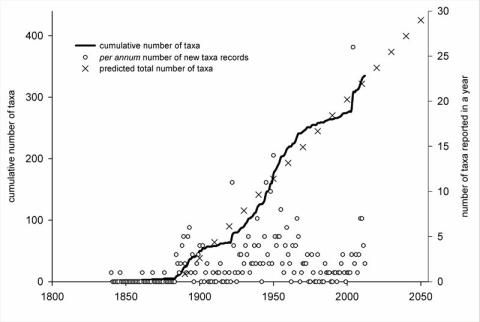15. janúar 2014. Pawel Wasowicz: Alien vascular plants in Iceland: past, present and future
15. janúar 2014. Pawel Wasowicz: Alien vascular plants in Iceland: past, present and future

Pawel Wasowicz, grasafræðingur hjá Náttúrufræðistofnun Íslands, flytur erindi sitt „Alien vascular plants in Iceland: past, present and future“ á Hrafnaþingi miðvikudaginn 15. janúar kl. 15:15. Erindið verður flutt á ensku.
Integration of human communities due to globalization provides many benefits through the facilitated movement of people and goods. This process, however, leads also to intentional and unintentional transfer of organisms between ecosystems that in the past were completely separated by geographic barriers. We term them alien species. Most of these species is unable to adapt to new environment and will die out shortly after introduction. Some other will establish permanent self-sustaining populations, subset of these will spread, and some of the spreading species will show negative effect on the environment. These harmful species are termed invasive alien species. While only a small percentage of transported organisms become invasive, they have a tremendous impact on environment and even human health. Their impact on the economy is also huge – they cause billions of dollars worth of damage annually.
Recent studies point out, that negative effects of invasive alien species on biodiversity can be intensified by climate change by favouring spread of alien species leading to new invasions and range expansion of already naturalised aliens. Recent studies evidenced also that global temperatures are increasing unevenly with the highest rate of increase in the northern latitudes. In light of this, arctic and sub-arctic territories, such as Iceland, seem to be most vulnerable to range shifts caused by global warming and consequently susceptible to the damaging effects of alien species invasions. When we take into account that isolated ecosystems, such as islands, are particularly vulnerable to any ecological disturbance, then the problem of alien species seems to be one of the important challenges that will have to be faced by us and future generations.
Hitherto, the knowledge on alien flora of Iceland was rather scarce, since the last comprehensive approach to the problem was the paper by Ingólfur Davíðsson published in 1967. To fill this gap scientist from the Icelandic Institute of Natural History undertook research aimed to provide general, but up-to-date analysis of the phenomenon of alien plant immigration, establishment and invasion in Iceland.
The talk is aimed to summarize the results of this recent research and will cover the following aspects:
- introduction to the problem of alien species (basic definitions, examples of the impact of alien species on ecosystems and economy)
- up-to-date information on alien plant species (diversity, basic statistics, temporal trends)
- spatial distribution patterns
- identification of major environmental factors that shape distribution of alien plants in the country
- prediction of the impact of climate change on the distribution of selected species
Questions and results discussed during the lecture are mainly based on findings recently published in the paper “Alien vascular plants in Iceland: Diversity, spatial patterns, temporal trends, and the impact of climate change” by Pawel Wasowicz, Ewa María Przedpelska-Wasowicz and Hörður Kristinsson.
